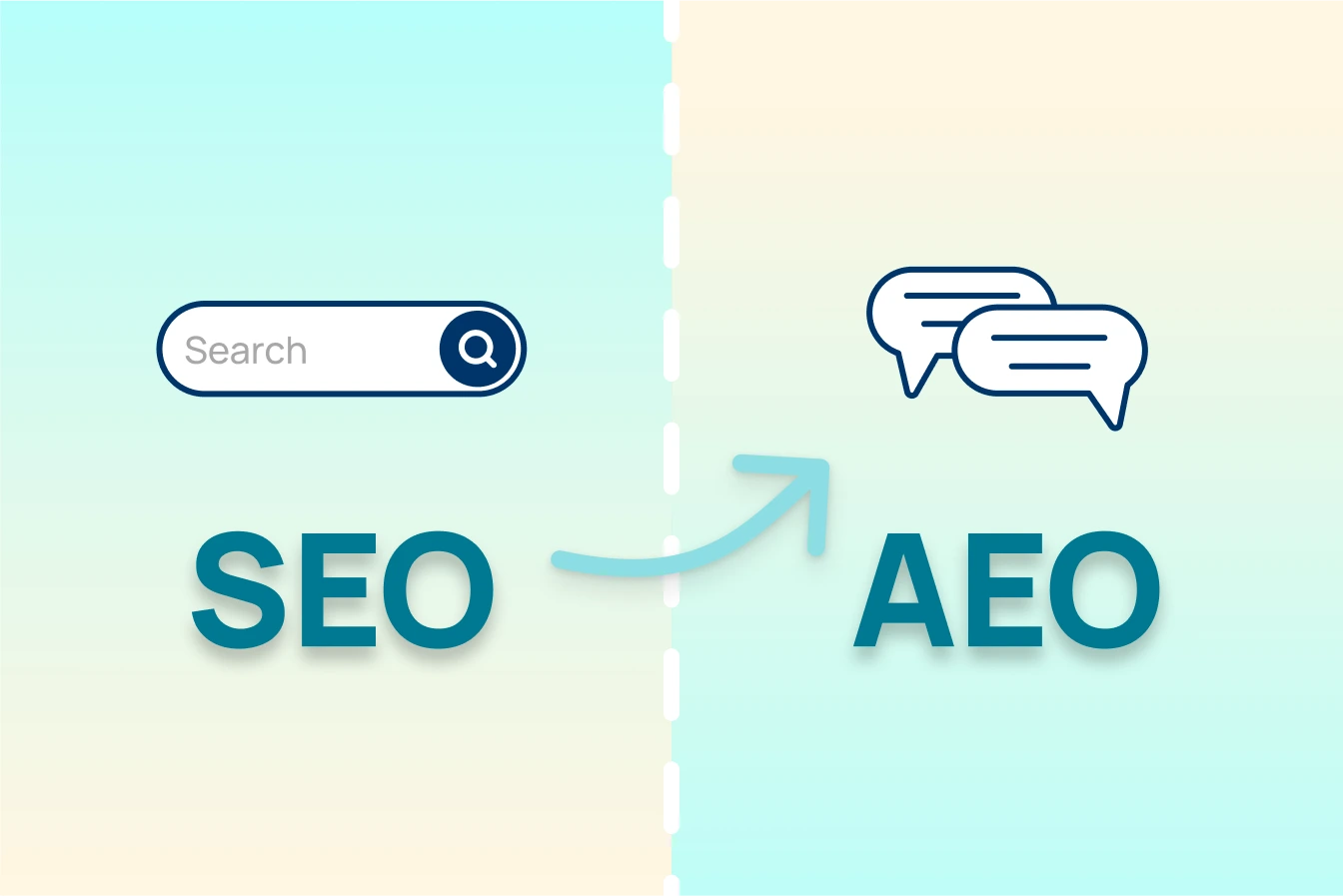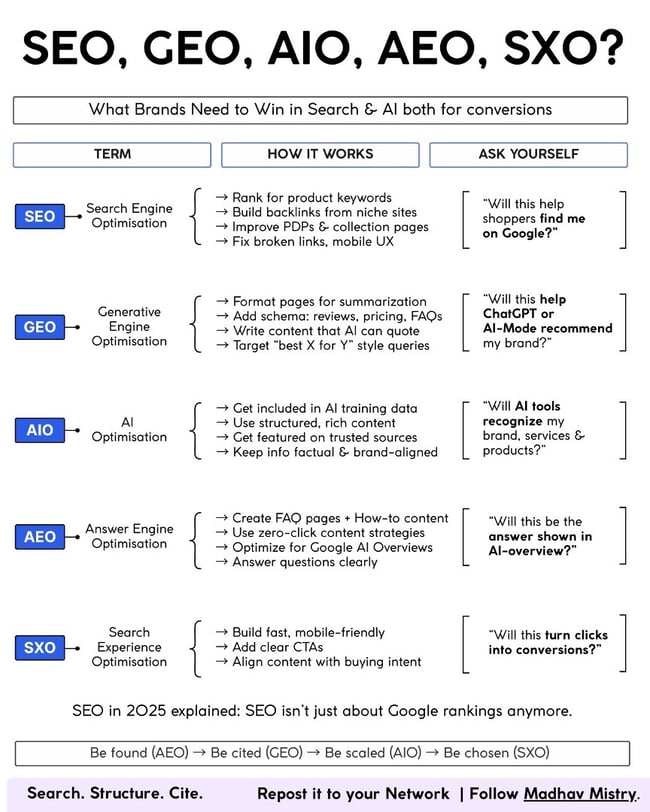Answer Engine Optimization (AEO) is revolutionizing the way brands are discovered and interacted with online. Learn how to adapt and thrive in this new landscape.
What's the difference between SEO and AEO?
Answer Engine Optimization (AEO) is at the forefront of content marketing transformation. Unlike traditional Search Engine Optimization (SEO), which focuses on ranking websites higher in search engine results pages (SERPs), AEO aims to ensure that a brand, product, or service is accurately represented in AI-generated responses on platforms such as ChatGPT, Perplexity, and Google's AI Overviews.
Initially, AI applications like early versions of ChatGPT relied on static snapshots of training data with no real-time internet connectivity, leaving brands with limited control over their representation. However, advancements have led to AI Answer Engines designed to synthesize and present content from the internet as concise answers, eliminating the need for users to sift through multiple search results. This shift is significant, with Gartner predicting a 25% drop in traditional search engine volume by 2026 as AI Answer Engines gain prominence.
|
SEO (Search Engine Optimization
|
Focuses on optimizing entire web pages to rank higher in search engine results through keywords, meta tags, and backlinks.
|
| AEO (Answer Engine Optimization) |
AI answer engines extract snippets rather than whole articles, brands must ensure consistent presence throughout all relevant content sections by integrating brand mentions and messaging broadly, not just in isolated parts.
They favor structured, comparison-driven, and expert-led content (tables, FAQs, side-by-sides). Content must be easy for AI to parse and cite.
|
Why AEO is Critical for your Website
The rise of AI Answer Engines marks a pivotal shift in how users interact with information online. Traditional SEO strategies, which focus on optimizing entire web pages for search engine algorithms, are becoming less effective. Instead, AEO requires brands to optimize specific chunks of content to be picked up by AI retrieval systems.
This new approach means that brands must focus on the quality, relevance, and authority of their content to ensure it is selected for AI-generated answers. The emphasis is now on creating high-quality, authoritative content that directly addresses user queries. Regular audits and updates are essential to maintain content accuracy and trustworthiness, aligning with Google's E-E-A-T framework (Experience, Expertise, Authoritativeness, Trustworthiness).

Source: Align.
AI Answer Optimization (AEO) Summary:
-
No Fixed Rankings: AI systems don’t use traditional ranking systems, making brand visibility unpredictable.
-
User-Centric Optimization: Important to map your real user prompts and optimize content to answer those, for both awareness and conversion-focused queries.
-
Tracking & Benchmarking: AI visibility tools can help you with real-time monitoring, source analysis, and competitor insights.
-
Personalized Responses: AI engines deliver personalized answers, depending on the user's history and location, not just the “best” one.
-
Citations Matter: Focus on earning citations from authoritative and overlapping sources. Distribute content on high-citation and influencer platforms.
-
E-E-A-T is Crucial: Experience, Expertise, Authoritativeness, and Trust are core factors in AI-driven content visibility.
Read here our deep research on AEO
What AEO Strategies to Implement Today
To thrive in the era of AEO, brands must adopt new strategies that cater to the unique requirements of AI systems. Here are some key practices:
- Optimize your content for featured snippets and AI overviews:
- Structure your content with clear headings and subheadings.
- Create high-quality content with real experts.
- Include “What is…” headings.
- Using “[TERM] is…” followed by at least two defining sentences
- Add original research: Case studies, proprietary data, and new findings become AI citation magnets.
- Ensure you add the author bio and how they have the expertise. Name the expert and link them to their credentials.
- Include digestible content: Short intros, key takeaways per section.
- Add the proper schema to your page’s source code. This increases the chances of your content appearing in featured snippets or AI Overviews.
- Focus on User Intent: Prioritize user needs and create content that addresses their specific queries. This involves understanding why users are searching for certain information and what they hope to gain from the results.
- Avoiding branded language in definitions.
- Create a Citation Overlap Strategy.
- Utilize Tools to monitor: Use tools to analyze how often your brand gets mentioned across AI-powered search engines. This can help identify strengths and weaknesses in your brand's visibility.
- Use HubSpot AI Search Grader
- Use HubSpot Blog Ideas Generator
AEO is leveraging Credible Voices and Original Data
One of the most effective ways to enhance your AEO strategy is by featuring credible voices and original data. According to Google's Search Quality Rater Guidelines, following the E-E-A-T framework is crucial. This involves collaborating with industry experts to enhance the credibility of your content.
For example, if your HR blog guides employee training, consider featuring quotes from professional trainers or inviting experts to write guest posts. Additionally, providing unique data and insights that can't be found elsewhere can significantly improve your content's authority and relevance.
EEAT Off-page Signals:
- Encourage authentic mentions on Reddit, Quora, and Stack Exchange.
- Gather reviews and ratings: G2, forums, testimonials (avoid marketing fluff).
- Build authoritativeness via guest blogging and collaborations with domain experts.
- Promote organic backlinks and real-world recognition (not paid PR spam).
Continue to Adapt and Optimize Your AEO Strategy
Answer Engine Optimization is not a one-time effort but an ongoing process. Continuous monitoring and adaptation are essential to stay ahead in the dynamic landscape of AI-driven search. In this context, it's also not the only concept important. Together with SEO and AEO, we also have to take into account GEO (Generative Engine Optimization), AIO (AI Optimization,) and SXO, Search Experience Optimization.
See below a short explanation on each one of them.

Source: Madhav Mistry
To keep up with the updates, it's important to:
- Use AI visibility tools to track real-time performance, citation/source analysis, and competitive benchmarking.
- Understand how your content is being retrieved and cited by AI systems, and make necessary adjustments to enhance visibility.
- Regularly update your content to maintain its relevance, accuracy, and trustworthiness, ensuring it meets the evolving needs of AI Answer Engines and their users.
As AI continues to reshape how people find and interact with information, traditional SEO strategies alone are no longer enough. To stay visible and relevant, brands must adapt to the evolving landscape of AI Answer Engines by focusing on user intent, personalized experiences, and trustworthy content.
Success in this space requires a shift in mindset—from chasing rankings to earning citations, from keyword stuffing to delivering real value, and from optimizing for algorithms to optimizing for humans guided by AI.
By aligning your content strategy with E-E-A-T principles, leveraging real-time AEO tools, and distributing your content across high-authority platforms, you’ll be well-positioned to stand out in AI-generated responses—and turn visibility into meaningful engagement and conversions.
The future of search is here. It’s personalized, AI-powered, and built on trust. Is your brand ready?
Read here our deep research on AEO